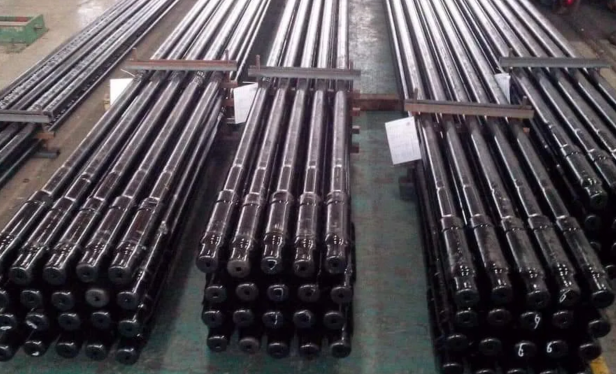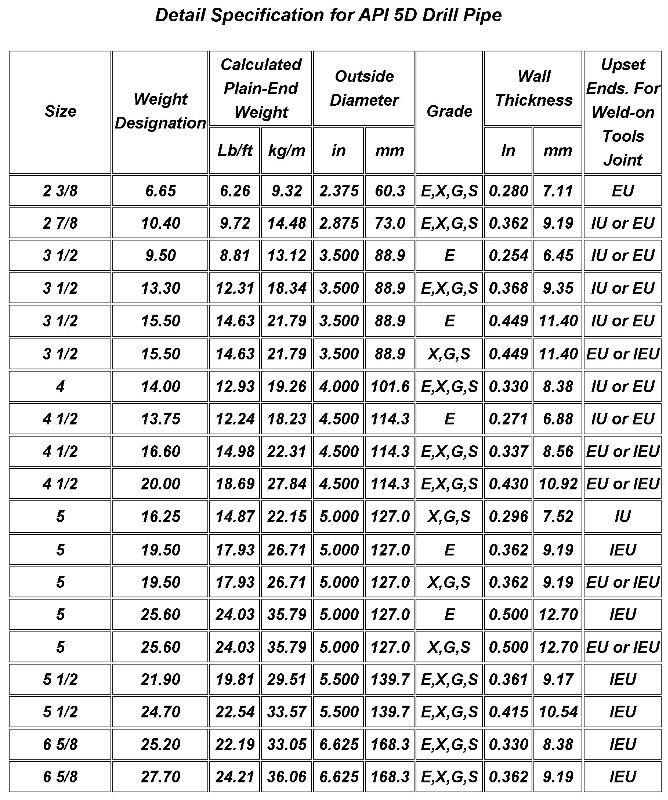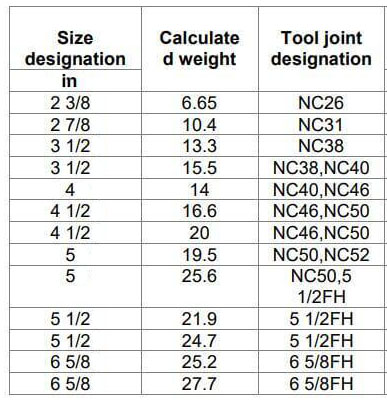Oil Drill Pipe, designed specifically for oil well drilling, plays a vital role in the drilling process due to its thin walls and low weight per unit length. It not only provides a smooth flow path for mud but also bears the heavy responsibility of transmitting tension and torque.
Oil drill pipe is made from high-strength seamless steel pipe using a special process. To enhance the connection strength between the pipe body and the joints, both ends undergo upsetting. According to API standards, upsetting can be categorized as internal upsetting, external upsetting, or internal and external upsetting. Common steel grades include: E75, X95, G105, and S135.

API 5DP Drill Pipe Specification:
Drill pipe used on oil drilling platforms comes in a variety of standard sizes, primarily categorized by its outer diameter. The most common outer diameter range for drill pipe used on oilfield sites is 2-7/8 inches to 6-5/8 inches.
Common drill pipe sizes include:
2 3/8", 2 7/8", 3 1/2", 4", 4 1/2", 5", 5 1/2", and 6-5/8".
These sizes are typically measured in both inches and metric units, with imperial units being the most common in the oil and gas industry. For example, 2 3/8 inches is equivalent to 60.3 mm. Different sizes are chosen to accommodate varying well depths and drilling requirements.
The dimensional parameters of oil drill pipe directly impact drilling efficiency and safety. Its specifications are defined by outer diameter, wall thickness, length, and joint type. The following is a guide to drill pipe size selection under the API 5DP standard.
API 5DP Drill Pipe Size Chart:

Note:
Common main sizes: 3-1/2", 4-1/2", and 5" (accounting for over 70% of global use).
Inner diameter calculation: OD - 2 × wall thickness (e.g., 5" drill pipe: 127.0 - 2 × 9.2 = 108.6mm)
Key Dimensional Parameters Analysis:
Other Important Considerations for Drill Pipe Selection:
1. Outer Diameter (OD) Selection Basis
Wellbore Size: The drill pipe OD should be 20-30% smaller than the drill bit diameter (e.g., 5" drill pipe for an 8-1/2" wellbore).
2. Wall Thickness (WT)
Drill pipe wall thickness varies, affecting its strength and weight. Thick-walled drill pipe has 15%-20% greater torsional strength than thin-walled drill pipe. Ultra-deep wells require heavy-weight drill pipe (HWDP), which has wall thickness increased by over 50%.
3. Drill Pipe Grade
Different grades of steel are used, designated by letters such as X, G, and S, representing varying strength and toughness.
Common steel grades include: E75, X95, G105, and S135. The E/X/G series are economical and are used for conventional drilling. S135 accounts for over 60% of global usage, offering a balance of strength and toughness. Higher-grade steel grades, V150/UD-165, contain V and Nb microalloys and have finer grains. They are suitable for ultra-deep, high-pressure wells exceeding 8,000 meters and are commonly used in polar and ultra-deep shale gas wells.
4. Tool Joints
Tool joints, which connect drill pipe sections, also have specific sizes and connection methods. According to the thread buckle type, drill pipe joints are divided into four connection types:
IF, FH, REG, NC.
5. Length
Drill pipe is typically 30 to 33 feet in length.
According to the latest edition of the American Petroleum Institute (API Spec 5DP), standard drill pipe lengths are divided into three series:
1. R1 Series (single length): 18-22 feet (5.49-6.71 meters), primarily used in shallow onshore well operations, offering ease of manual handling and quick connection.
2. R2 Series (twin length): 27-31 feet (8.23-9.45 meters), suitable for medium-sized drilling rigs, balancing efficiency and maneuverability.
3. R3 Series (triple length): 38-45 feet (11.58-13.72 meters), commonly used on deepwater drilling platforms, reducing the number of connections to improve efficiency.
Connector Type and Size Matching:
According to the thread buckle type, drill pipe joints are divided into four connection types:Internal flush connection (IF), Full hole connection (FH), Regular connection (REG), Numbered connection (NC).

Steel Grade and Size Coordination:
Steel Grade
|
Yield Strength (MPa)
|
Recommended Size
|
Typical Applications
|
E75
|
517-655
|
2-3/8"-3-1/2"
|
shallow wells, geological exploration
|
|
S135
|
931-1138
|
4-5-1/2"
|
deep wells, shale gas horizontal wells
|
|
V150
|
1034-1172
|
4-1/2"-6-5/8"
|
ultra-deep wells (>8,000 m)
|
|
UD-165
|
≥1172
|
5-1/2"-6-5/8"
|
polar/ultra-high-pressure wells
|
Dimension adjustments for special operating conditions:
1. Horizontal wells/extended-reach wells
Increase the outer diameter (e.g., 5" instead of 4-1/2") to reduce friction
Use high-torsion joints (NC50 or 6-5/8" REG)
2. Sour environments
Select thick-walled drill pipe to reduce stress corrosion risk
Steel grade must meet NACE MR0175 Standards
3. Deep-sea Drilling
Use large-diameter drill pipe (6-5/8") to improve circulation efficiency. The material must be low-temperature resistant (-20°C impact energy ≥ 54J).
In short, precisely matching drill pipe size and connector type can increase drilling efficiency by over 30% while reducing the risk of accidents such as stuck pipe. In the future, large size, high strength, and intelligent technology will be the main development trends.
Read more: Casing pipe vs Drill pipe or Drill Pipe and Drill Collar




